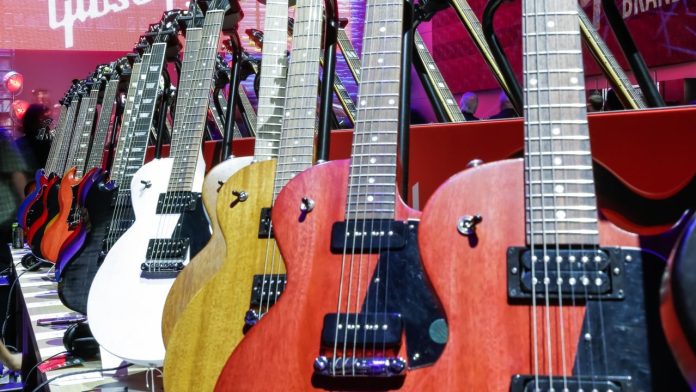By Nate Pallesen | Wealth of Geeks
Crafting musical instruments isn’t usually rocket science. Malayan Guitars saw that as a challenge. The crisp, clean tunes generated by these innovative instruments come from NASA-patented technology and ultrasound, reinventing what it means to make guitars electric.
Kuan Eng, founder of Malayan Guitars, told Claudia Khaw with Vulcan Post, “I felt a need to improve the electric guitar, and after getting some great initial feedback from professionals, I felt like I was meant to do this work.”
Malayan Guitars is poised to shake up the music industry.
Birth of Malayan Guitars
From a young age, Kuan enjoyed the physics behind music but didn’t care for an electric guitar’s distinct sound. He dug into architecture, medicine, physics, and engineering while collecting acoustic and electric guitars. During his university education in London, where he obtained a Bachelor’s degree in science, he played guitar and researched ultrasound machines.
After his return to Malaysia in 2017, Kuan found himself with spare time. During that downtime, he decided to tackle and improve the electric guitar. “I found the 1960s sound quality of electric guitars unacceptable in this modern time,” he stated. His main goal was to increase playability.
Reinventing a Time-Honored Instrument
From the feel of the guitar to the electronics within, Kuan envisioned an instrument that looked and sounded better than ever before. He sought to develop a guitar that competed with the low-cost, less ergonomic options flooding the market. He adds, “I realised [sic] that the flooding of the local market by low-quality guitars has done the entire guitar-playing community a great disservice, and I work to provide an alternative to low-cost, mass-produced guitar,”
After testing a prototype, Kuan launched Malayan Guitars in 2019 to secure overseas components. Then, he crafted a second one to explore the design’s viability further. The testers of the second prototype included Az Samad, a Berklee College of Music graduate; Kyoto Protocol’s frontman, Fuad Alhabshi; and Nik Azam of Ceriatone Amplification.
Their feedback ultimately led Kuan to devote 90% of his time to his guitars. While he may not be a doctor or scientist as his parents wished, Kuan utilizes his education. He incorporates NASA-patented electronic circuits in every guitar.
The circuits are analog devices capable of accommodating a range of frequencies without distortion. Each analog circuit is custom-built, ensuring that every guitar is responsive and produces sounds the musician wants to hear.
The Beauty of Malaysian Wood
In addition to NASA technology, each guitar also contains local Malaysian wood. Numerous parts of the guitar, including the headstock, neck, and body, are shaped from high-quality wood that Kuan hand-selects. Kuan sources the wood from local sawmills for wood with the exact properties his custom guitars require.
“Malaysia is blessed with some amazing trees that yield wonderful wood,” expresses Kuan. His selectivity is for a reason: every piece of wood, even those cut from the same tree, could be dramatically different.
Kuan uses both hard and soft wood in his designs. He often chooses Kayu Besi, or Malayan Ironwood, as its strength and resilience make it an ideal wood for a guitar neck. For other pieces that need flexibility, he selects softer wood. Those pieces are then expertly joined at his workshop to create the body of a brand-new guitar.
The Cost of Innovation
Building custom analog circuits and wooden guitar bodies does come with a cost. Kuan revealed that the construction of one instrument takes him hundreds of hours. The process begins with the objectives. Before progressing to sketches, he decides if the guitar will have a unique shape or specific sound. Once the sketches are complete, Kuan evaluates and refines the design.
“There will be many formulas and calculations regarding the structure of the guitar and its electronics,” Kuan explained in the Vulcan Post interview. “Custom tools, jigs, and workshop fixtures have to be made for each guitar model.” He added that some designs challenge him to think outside the box and utilize new construction methods.
He then spends a few hours ordering the parts he needs. From there, it takes Kuan about 30 to 60 hours to build the guitar, 10 to 20 hours to paint and polish the wood, two to six hours to craft the hardware and electronics, and another few hours to accommodate any customer requests.
Kuan is the only one in his company making the labor-intensive guitars, contributing to the custom-built guitars’ price point — somewhere between $1,250 and $2,500. Kuan’s most expensive piece was sold to an overseas collector for more than $4,000. Such a price tag is far above the average price of an acoustic guitar in the U.S.
Guitars Made With Rocket Science
Kuan Eng set out to recreate the guitar using a combination of science and art. Although Malayan Guitars is a demanding solo entrepreneurial project, Kuan believes in his dream.
“The mission is to grow the entire guitar-playing community in Malaysia,” he explained to Vulcan Post. “Music is something the world needs. I have too many ideas and designs to explore now to even think about slowing down.”
With their futuristic technology and sound, Kuan’s guitars will surely draw the attention of many musicians. Perhaps Malayan Guitars will one day become a well-known brand like Ibanez or Fender.
This article was produced by Media Decision and syndicated by Wealth of Geeks.




